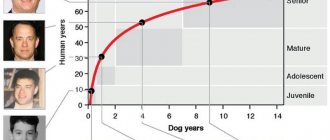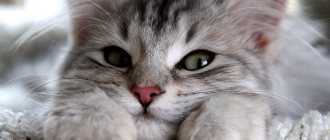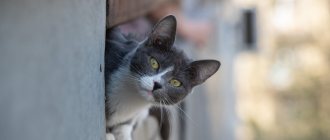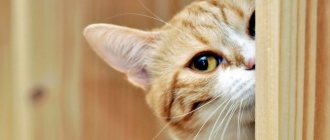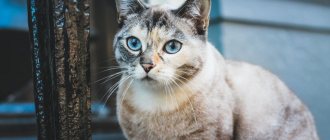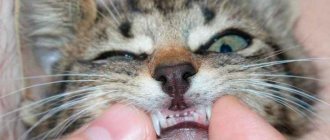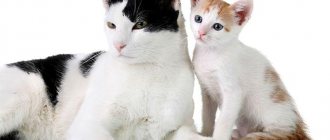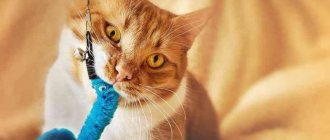Sooner or later, every pet owner thinks about how long cats live, and whether it is long or short by human standards.
To correctly determine the age of a cat by human standards, it is necessary to study the individual characteristics of their body and habitat.
It is very important to correctly determine a cat’s age in order to subsequently track important changes: puberty, the development of pathologies and senile deviations. This knowledge will help provide timely assistance to your pet.
How to find out how old a cat is?
It is possible to calculate the age of a cat at home, although these data are considered approximate. This can be determined based on the data of the international veterinary passport of cats. This allows you to timely monitor age-related changes in your pet, providing it with the necessary measures to maintain its health.
Tough
Teeth are a kind of factor indicating age. When determining it, a person relies on the condition of his teeth, because over the years their appearance changes, despite the replacement of milk teeth with molars. Despite the fact that in some animals they are strong until old age, and in others they are sick almost from childhood, age can be determined by such signs as:
- shade of teeth;
- stage of attrition;
- accumulation of tartar;
- number of dropped units.
Cats whose owners brush their teeth and who visit the dentist have well-groomed teeth, which sometimes creates the illusion of a younger age. If kittens have an incorrect bite, dental problems cannot be avoided, and this adds age to the existing years.
Cats have excellent dental health within a year. At this time they are white, without ingrained yellowness and tartar deposits. At 2 years of age, the incisors begin to wear off, which is still not noticeable from the outside. A two-year-old cat has yellow teeth only if the owner does not brush them. By the age of four, the central and middle incisors are noticeably worn down. At the age of 6, the canines and outer incisors wear out, and at the age of 10, teeth begin to fall out. At 15 years of age, some individuals lose their fangs.
By the eyes
Like people, cats lose visual acuity over time, which is explained by the condition of the lens, and is also noticeable in the iris. A veterinarian can determine the age. Young animals do not have increased lacrimation. As for the iris, the more irregularities and inclusions it has, the older the cat.
According to the condition of the musculoskeletal system
You can understand the age of a cat by the structure of the musculoskeletal system, which affects the manner of movement. For example, kittens have disproportionate paws and are long relative to their body. A six-month-old baby seems lanky, after the end of puberty his body becomes stately and his gait becomes graceful. Kittens' ears grow faster than their skulls, but by the end of their growth this becomes unnoticeable.
Young cats are different in appearance; they have developed muscle relief. Their movements are easy and relaxed, at this age they are capable of long distances, and sometimes even shock the imagination with acrobatic tricks. This goes away with age: older animals remain agile, but over time they develop weakness in the joints. In addition, their spine may lower, they may experience protruding shoulder blades, thinning muscle relief, and weight loss.
By other external signs
You can determine the pet's age based on the condition of the coat (irrelevant for hairless cats). Despite the fact that the method is not as reliable in comparison with determination by teeth and eyes, it is no less interesting. For example, kittens up to one year old have a softer and silkier coat. There are practically no tangles on it, the condition is good, indicating excellent health.
Gray hair appears in cats when they are 7 years old. Early gray hair indicates the presence of diseases, for the solution of which you need to consult a doctor. From the age of 8, a fur coat becomes less attractive, and therefore the owner has to more carefully monitor its health and beauty.
In addition, you can understand that a pet has reached sexual maturity by its behavior. For example, starting from the age of six months, cats begin to actively mark their territory with their own urine, which has a pungent odor. Compared to human standards, at this time they are like teenagers with their rebellious spirit.
There are conventionally developed tabular data that clearly shows a person how old his pet is. The disadvantage of the data shown in the table is its inaccuracy.
As for a more accurate calculation option, to calculate it you need to have an idea of each stage of animal development. This allows you to paint a mental portrait by human standards. In cats of different breeds, the life resource during which a kitten is born, develops and grows old passes at its own pace.
For example, representatives of the Snowshoe breed reach venerable old age at 10-11 years of age. Asian tabbies live up to 20 years, Tiffany and smoky cats live up to 18, and some record holders of the cat family reach the age of 30 years.
Ratio table
Like people, animals go through several stages of growing up: childhood, puberty, maturity and old age. It is necessary to take into account the rate of change at a particular stage in order to find out how old a cat is by human standards. The table below details the pet's maturation:
| Life stage | Cat age | Human equivalent |
| Kitten (birth – 6 months) | 0-1 month | 0-1 year |
| 2 months | 2 years | |
| 3 months | 4 years | |
| 4 months | 6 years | |
| 5 months | 8 years | |
| 6 months | 10 years | |
| Adolescent/young (7 months – 2 years) | 7 months | 12 years |
| 12 months | 15 years | |
| 18 months | 21 g | |
| 2 g | 24 g | |
| Adult (3-6 years old) | 3 g | 28 years |
| 4 g | 32 g | |
| 5 years | 36 years | |
| 6 years | 40 years | |
| Mature (7-10 years old) | 7 years | 44 g |
| 8 years | 48 years old | |
| 9 years | 52 g | |
| 10 years | 56 years old | |
| Elderly (11-14 years old) | 11 years | 60 years |
| 12 years | 64 g | |
| 13 years | 68 years old | |
| 14 years | 72 g | |
| Very old (15 years and older) | 15 years | 76 years old |
| 16 years | 80 years old | |
| 17 years | 84 g | |
| 18 years | 88 years old | |
| 19 years | 92 g | |
| 20 years | 96 years old | |
| 21 g | 100 years | |
| 22 g | 104 g | |
| 23 g | 108 years old | |
| 24 g | 112 years | |
| 25 years | 116 years |
The calculation starts at a rate of 1 in 12, peaking at one year of age (1:15) and gradually falling to a ratio of approximately 1:4.6. It shows that the pet is a dynamic variable.
It is necessary to build on current figures in order to understand and determine how old the cat is by human standards. The table describes in detail the interspecific proportions.
Determining age by external signs
Animals are not always adopted by owners in infancy. If a person has an adult cat, an examination will help determine its age:
- Body. An animal that has survived several years on the street has dense muscles. Brownness is a sign of most homeless individuals. But the young cat has soft muscles. Years of fighting for territory form a densely built body with a minimum fat content, accumulating, if possible, in preparation for winter. In older individuals, sagging skin on the abdomen (under the arms) and protruding shoulder blades are observed.
- Teeth. A white, healthy jaw is a sign of an individual aged 1-2 years. Of course, kittens can also have dental problems. But it is possible to distinguish inflammation caused by poor nutrition from plaque that has formed over the years. The latter may not cause discomfort, but will stain the enamel dark.
- Wool. Helps to determine by touch the age of a cat by human standards. The table indicates that the pet lives more than 100 years, when translated into the owner's chronology. The older the individual, the tougher its pile. Older animals may also experience gray hair and localized baldness.
- Eyes. In young people - clear, without signs of tears or mucous discharge in the corners. Although their appearance is also facilitated by pathogens and weakened immunity. The texture of the iris is one of the ways to determine the age of a cat by human standards. In young individuals it is relatively uniform - with the exception of pigment spots or traces of injury. With age, the vessels of the organ appear. Lacrimal tracks are also formed, into which secretions caused by injuries, infections and inflammatory processes flow.
People communicate not only with pets, which they raise from infancy. Having realized that a 7-year-old cat by human standards is equal to 44 years old, they can begin to have great respect for their dacha “neighbor” who has survived another winter. Understanding the relationships will also help in communicating with your own pet.
Why know your pet's age in human equivalent?
Life expectancy depends on conditions. So, the tramp will be lucky to celebrate 9 years - the cat, by human standards from the table, will turn 52 years old. In human terms, he will not even cross retirement age. On the street, an individual risks not living to see its 5th anniversary due to: transport;
- clashes with relatives and other animals;
- poor quality nutrition;
- atmospheric phenomena.
The home offers the pet a comfortable environment. But the owner should also recalculate the cat’s age in human years. When an animal enters the elderly phase, it becomes more susceptible to:
- cancer;
- diabetes;
- cardiovascular diseases;
- problems with kidneys and other organs.
The root causes of illness are poor diet, infections, injuries or contact with pathogens, such as fungus in the bathroom. But age additionally increases the likelihood of developing diseases due to weakened immunity.
As in the case of a person celebrating his 60th birthday, an animal older than 8-10 years needs attention to its health.
If castration (sterilization) has not been performed, the individual should be checked regularly (at least once a year) for signs of genital cancer. Regular examinations are also necessary in the presence of chronic diseases.
If at 6-7 years old a pet with kidney failure had enough proper nutrition, then after the 10th anniversary it is better to periodically (1-2 times a year, in the absence of signs of inflammation) give urine for analysis. For problems with the heart and other organs, regular checks are also advisable.
You should refrain from preventive visits to the veterinarian if your pet is nervous. If an elderly individual does not show signs of illness (weakness, anxiety, refusal to eat, etc.), there is no need to expose her to unnecessary stress.
Like any animal, a cat goes through several stages of development. These stages must be taken into account when comparing a pet's age to a human's. An individual grows fastest during the period of up to 6 months. Then the speed slows down gradually, reaching a ratio of 1 cat year to 4.5-5 human years.
Knowing the proportion will help calculate the age of the animal at a specific point in time and adjust its care at different stages of development.
The table also makes you think about the pet’s quality of life. So, if we start from the “dog” variable, a 15-year-old cat corresponds to a 105-year-old person (82.5 years, if we take a multiplier of 5.5). Respectable age.
But a dynamic calculation shows that such an individual dies at 76 years of age. Not much compared to a person who has access to quality food and health care. By monitoring the health of the pet, owners can ensure its “centenary” anniversary.
How to extend the life of cats
During the growth and development of an animal, it is accompanied by various ailments. As a rule, they are all associated with poor nutrition, a sedentary lifestyle, and a lack of vitamin and mineral components, which leads to negative consequences and a reduction in the life expectancy of pets.
Based on this definition, there are ways that can extend the life of cats. Such decisions should include:
- Pets should be fed exclusively with healthy and nutritious food products, as well as premium store-bought food.
- Get vaccinations recommended by specialists in a timely manner, and also visit your veterinarian regularly.
- A pet should be in constant motion, regularly visiting the street.
- Regularly prevent infection of domestic animals with ectoparasites and worms.
- Constantly monitor the condition of the skin, coat, as well as the eyes, ears and teeth of your pet.
- If the animal is not intended for breeding work, then it must be castrated or sterilized in a timely manner.
- After six months of life, large amounts of milk should be excluded from the cat’s diet, as this promotes the production of lactase.
- The diet should include a sufficient amount of raw meat, but only high-quality meat in the form of lean beef or chilled poultry.
- Do not practice sudden transitions from one type of nutrition to another.
- Do not allow your pet to constantly overeat, otherwise this can lead to obesity and further heart problems, constipation and diabetes.
Organizing proper nutrition for a pet using only high-quality food or ready-made diets, along with care and love for the pet, are the fundamental factors that have a major impact on the life expectancy of cats.
At specialized retail outlets you can purchase factory-made, ready-made food rations that are balanced in terms of vitamins and minerals. There are brands of diets that have proven themselves well and are very popular. These are diets such as ProPlan, Brit Premium and Brit Care, Royal Canin, Hills and others. In any case, you can get comprehensive information from the sellers of this product.
When feeding your pet with natural foods, you should not feed certain foods from the table, such as fried, salted or pickled foods, sweets, including baked or flour products.
It is strictly forbidden to give cats or add various flavorings, flavor enhancers or seasonings to products intended for feeding cats.
Particular attention should be paid to the diet used to feed spayed or neutered animals, as well as those animals that have any health problems
Is it possible to increase the lifespan of a cat?
Any owner dreams of having a furry family member to please him for as long as possible. And he has the power to do everything so that the cat lives for 15, or even 20 years. What will prolong the life of your beloved four-legged animal:
- Annual vaccination
. The kitten is vaccinated in the first 2-3 months of life and then the procedure is repeated every year. This will protect both your indoor and outdoor cats from the most terrible viruses with a high fatality rate.
- Routine examination by a veterinarian
. Non-pedigreed cats get sick less, so they can be shown to the veterinarian during vaccination once a year - just ask the doctor about this. Pedigree animals and animals with chronic diseases require more frequent visits to the veterinary clinic - the frequency will be determined by the veterinarian himself.
- Sterilization and castration
. If you do not plan to breed kittens, be sure to sterilize your pet - this will help avoid many problems, including diseases of the genitourinary system and mental disorders.
- Attention to any changes in your pet's behavior
. Has your cat started drinking a lot? Stopped sleeping in your favorite chair? Is he limping? Are there strange discharges? Even such little things require close attention from the owner. The first action in case of suspicion is to call the veterinarian, he will tell you whether you need to take the animal to the clinic or if you can watch it at home.
- Purity
- the key to health. Cats groom themselves, but this is not enough to maintain hygiene. For example, long-haired breeds cannot cope with caring for a luxurious fur coat, and it must be combed regularly to prevent parasites or skin diseases. It is necessary to thoroughly rinse the cat's food and water bowls, disinfect the trays, and wash the bedding.
- Nutrition
must be maintained at a high level. It is not so important what you feed your cat - the main thing is that the selected diet suits it. A young cat will benefit from both natural food and high-quality dry food. But kittens and elderly individuals require a special menu, which cannot be cheap. Therefore, before getting a cat, think about the fact that in old age, in 95% of cases, it will require greater expenses than in youth.
- Treat your cat like a family member
. Consider the nature of the pet and its needs. If she doesn't tolerate loneliness well, you shouldn't leave her in the apartment all day. And on the contrary - if the kitty loves isolation, respect her personal space. There are many such points, and if you do not pay attention to the psychological state of the animal, it will constantly be sick and will not live very long.
This is not a complete list of what a loving owner can do. The most important thing is to be attentive and patient, treating your pet as a younger member of the family. Then he will live very long and happily.
Different “translation” systems
There are quite a few of these systems.
The simplest and practically useless is multiplying the cat’s age by 7. It’s easy to see that it doesn’t work: just compare an almost adult, strong, sexually mature one-year-old cat and a seven-year-old child.
Therefore, translation systems began to become more complex and improved.
One of them says that the first year of a cat’s life is equal to 15 human years, the second year is another 9 (that is, a two-year-old cat is the age of a 24-year-old human). Then every year goes by 4.
According to another system, up to the age of five, every year cats are counted as 7 human years, then - as 4 human years, after 12 years - as 3 human years. But this is too simplistic.
It seems to me that the complex system of matching cat and human ages is more likely to be true, when for each year of a cat’s life (and in the first year of life and for each month) a coefficient is calculated that determines how many cat years are in one of our years.
According to this system:
- a one-month or two-month-old kitten corresponds to a child 6-10 months old (coefficients 6 and 5);
- a three-month-old kitten - a two-year-old (coefficient 8);
- for a four- to five-month-old animal, whose cognitive activity is simply off the charts, the coefficient increases sharply, reaching 15 and 19, that is, kittens of this age correspond to children 5-8 years old;
- at the age of 6-8 months, when kittens go through puberty - a very important stage in the development of any mammal - the compliance coefficient increases even more, reaching 24-28, and turning kittens into teenagers 14-16 years old;
- then the coefficient begins to decrease, and in each cat year there are fewer and fewer humans: a one-year-old animal approximately corresponds to an 18-year-old person (coefficient 18), a three-year-old - to a thirty-year-old (K = 10), a five-year-old - to a forty-year-old (K = 8), a cat aged 10 years - this is a 60-year-old pensioner (K = 6), and a twenty-year-old centenarian, by human standards, is exchanging the century mark (K = 5).
Age comparison principles
There is an opinion that in order to calculate the age of a cat by human standards, it is enough to multiply it by seven. In fact, this approach is only valid for animals between three and ten years of age.
They grow up and grow old at a completely different pace than humans.
It is necessary to take into account the principles of recalculation:
- There is no calculation formula for cats under three years of age.
- A three-year-old animal reaches approximately the same degree of development as a person at 25-30 years old.
- From three to five years, this figure increases by 7 every year.
- From five to twelve years – by 4.
- After twelve years, each year is counted as 3.
How to extend the life of a pet
A cat's age in human terms is not so fleeting. However, a loving owner always wants his ward to live as long as possible. What depends on the pet owner? You might be surprised, but a lot!
- Follow the recommendations of veterinarians and breeders regarding housing conditions and nutrition (for each individual breed).
- Get vaccinated.
- Do not forget about anthelmintic and disinfectant measures.
- Take your pet out into the fresh air and play with him.
- Never punish your pet for pranks, but teach him to use the tray and scratching post from childhood.
- Provide timely assistance if necessary (injuries, diseases, allergic reactions, pathologies of any etiology).
Important! Do not self-medicate, but seek help from a public veterinary hospital or private clinic. Take a responsible approach to keeping your pet, show affection and care, and then he will delight you and other household members with his presence for many years
Take a responsible approach to keeping your pet, show affection and care, and then he will delight you and other household members with his presence for many years.
By behavior
It is possible to determine the age of a pet by its behavior. This method is quite subjective and depends on the character of the animal, but there are still common features in habits.
Baby kittens spend almost all their free time playing and communicating with each other and people. They are even ready to courageously sacrifice minutes of sleep for the sake of fun! Some kids even insistently demand attention to themselves.
Mature pets will enjoy spending time hunting and playing. However, they tend to be very sleepy.
Best articles: On which continent is the deepest river on Earth located?
Older cats no longer like unnecessary fuss, preferring quiet rest to noisy games. Pets can often be found dozing peacefully on a chair or on your bed. As cats age, their hearing often becomes dull and their vision begins to decline, which can cause the animal to become a little more fearful or nervous.
Comparison of the age periods of a cat and a person
Infancy
The period of infancy in a kitten passes more quickly than in humans. It only lasts a few weeks. During this time, the kitten goes through a difficult period, discovers a new world, and learns to walk.
shutterstock
Kittens are born blind, deaf and completely helpless. A week later, the protective film on the ears disappears, and the eyes open 5-9 days after birth. In the second week, teeth begin to cut. If we translate this age into human terms, then in our children this period begins 5-9 months after birth.
Month-old kittens are already running and jumping, that is, this is about a year and a half of a cat by human standards. A three-month-old cat is comparable in intelligence to a two-year-old child.
Childhood
Cat children develop very quickly, so it is not easy to compare this period with human children. At 4 months of life, these animals are already actively playing and communicating with other pets, recognizing “friends” and “strangers,” and can take care of themselves without the help of their mother (lick their fur, wash their faces, sharpen their claws, feed on their own). They learn all this from their mother’s example, although instincts also play an important role.
During the first year of life, a cat goes through all the stages of growing up, which is comparable to 18 years of human life.
This is why you should pay maximum attention to training your pet before he develops habits and games that you do not want or cannot tolerate. You must teach him that he cannot go to the toilet wherever he wants, he cannot sharpen his claws on furniture, etc.
Teenage years
You cannot treat adult cats like children; you cannot help but react to aggression, “puddles” and other harmful pranks, thinking that with age this will all stop by itself. Remember that a 6-month-old cat is comparable in human years to an already developed human teenager.
Although the kitten looks small and cute, like a child, it begins to test the boundaries of what is permitted. If the owner wants to raise an obedient cat, it is necessary to firmly and promptly stop “rebellion”.
The next unpleasant surprise for cat owners at this unusual age of animals is puberty. At the age of 6.5 months, female cats begin to go into heat, and male cats, in turn, can react to them, since they are already quite ready for mating. However, it is undesirable to allow mating, because during this period the cat is not yet ready for childbirth or motherhood, but she can become pregnant.
shutterstock
Youth
During its youth, the cat is strong, agile and tireless. For purebred cats, this is the best period for various competitions and exhibitions. Up to 7 years of age, the animal is optimally suited to have healthy offspring.
Maturity
This period can begin at the age of 6-10 years. By human standards, this is approximately 40-55 years. The cat can still play sometimes, but more often he behaves calmly. People who are engaged in professional breeding of purebred cats remove animals that have reached this stage from mating.
Old age
An elderly cat is considered to be an animal aged 10-12 years, although there are individuals that live up to 20 years.
Therefore, such an honorable age does not necessarily symbolize the proximity of death. It all depends on the conditions of its detention and state of health. For example, street cats rarely live to be 10 years old, while indoor cats often cross the 16-year threshold.
Don't be afraid of a cat's old age; with proper care, they feel great. It is not uncommon to find long-lived cats that live up to 20 years or more. For example, the Texas cat Pushinka lived 38 years.
https://youtube.com/watch?v=sffK5XP0Bfw
Lifespan of cats and its extension
There is a pattern in nature: the smaller the animals, the shorter their life span. Cats are an exception in this regard - they live relatively long for their size. They usually manage to live to be fifteen to twenty years old.
The oldest one, according to the Guinness Book of Records, is 38 years old (about 145 years old by human standards).
Among the factors on which the longevity of these animals depends are the following:
- Breed. For example, Snowshoes live on average 11 years, American Bobtails - 13, Scots - 14, Persians, Sphynxes and British - 15, Maine Coons and Kuril Bobtails - 16, Tiffany - 18. Siamese, Thais and American Shorthairs, which often live up to 20 years.
- Lifestyle. Movement is a very important need for an animal. Passive pastime shortens his life.
- Nutrition. An unbalanced diet negatively affects the general condition of the body. Both a deficiency and an excess of certain substances have a negative impact.
- Sexual activity. Unsterilized cats and cats must have the opportunity to realize their sexual instincts - otherwise the hormonal balance in the body is disrupted.
- Psychological condition. Stress and emotional stress lead to neuroses and shorten life.
Stages of life
- First stage: childhood. Lasts approximately six months after birth. During this time, the kitten learns about the world around it and its dangers, and constantly receives new information. For now, he walks next to his mother, who teaches him everything and protects him from dangers. At the end of the first stage of a cat's life, we have an 8-12 year old child.
- Second stage: youth. Lasts from six months to two years. Feline puberty, period of growing up, puberty. By the age of one year, the cat is already biologically ready to give birth, but it is better to wait until two years - by this time she has acquired all the vital skills and abilities.
- Third stage: youth. Peak of development and activity. It lasts from three to five years. The cat is playful, intelligent, inquisitive and very active. Ready to reproduce healthy offspring. If we compare this with human life, then here we are no longer a teenager, but a young man who has graduated from university and found a good job.
- Stage four: maturity. From the seventh to the tenth year of life. The cat becomes cynical and indifferent in its views on the world; it worries it less. More time is spent sleeping, and the animal’s gaze itself becomes disdainful and proud. The cat is still healthy and has a lot of energy, but she no longer has much desire to waste it on stupid games.
- Fifth stage: retirement. It is only thanks to today's veterinary advances that cats have begun to discover this magnificent stage of their lives en masse. Now they enjoy life like people of about 60-70 years old. Such animals live exclusively for themselves and for their own pleasure. They sleep, eat and look at the birds in the windows for a long time, no longer trying to catch them, no longer getting nervous.
- Sixth stage: old age. Cats at 15-16 years old are already considered long-lived. If your pet or pet survives to this stage, you are lucky. During this period of life, they become affectionate, faithful, and require more attention, love, care and warmth.
https://youtube.com/watch?v=sffK5XP0Bfw
https://youtube.com/watch?v=sffK5XP0Bfw
Long-livers in the world of cats
You always want to believe that a pet will become a happy exception and turn into the smartest/obedient/beautiful/healthy/long-living cat in the world. And indeed, this sometimes happens - and not so rarely. But some cases are like a miracle.
Long-lived breeds
Before getting a purebred cat, it is advisable to find out what diseases it is predisposed to and how many years it lives on average. Breeds that can easily live 18-20 years include:
- Savannahs (one of the most expensive cats);
- Siamese cats;
- Manx;
- Persian cats;
- rexes (Cornish, Devon and others);
- Egyptian Mau;
- Burmese;
- Russians are blue.
Their life expectancy is due to good genetics and good health. However, this list can include the most common “breed” in the world – an ordinary yard cat. Outbred mustachios easily break records, living up to 20 years with good care and the absence of diseases.
Record holders
There are two cats in the world who are over 45 years old - but both of them are not registered in the Guinness Book of Records, since there is no official confirmation of their age. Here are the animals that have received world recognition as record holders for life expectancy:
- Bagheera from Russia – 34 years old;
- Rubble from the UK - 31 years old;
- Cream Puff from the USA - 38 years old;
- Nutmeg from the UK - 32 years old;
- Scooter from the USA - 31 years old.
This is not a complete list of cats that lived 30 years or more. There are numerous references to other long-lived pets who have surpassed the 25-year mark. So the long life of a fluffy is not such a rarity, and one can only rejoice at this.
Independently determining the age of a pet by human standards at home is a rather difficult, but doable task. For this, at least a superficial knowledge of animal anatomy will be useful - then the degree of maturity can be determined by the condition of the oral cavity, coat and musculoskeletal system. Behavioral and mental abilities will help clarify this meaning. For those who prefer exact sciences, formulas for calculating the number of years based on available data will be useful.
The article is for informational purposes only. Contact your veterinarian!
How to determine the age of a cat by external signs
It is extremely difficult to determine the age of an adult cat by its appearance. Often animals of very advanced age do not look decrepit and weak. If the age of the new pet is unknown, you can try to find it out using the following parameters:
- Teeth. The only reliable criterion for determining age is the appearance and change of teeth - useful only for kittens. At 2-3 weeks, babies develop incisors, at 3-4 - canines, at 3-6 - premolars. Then, at 3-4 months, the incisors change, and at 4-6 months, the remaining teeth. By 7 months, the change of teeth is completed. After 1-1.5 years, a yellowish coating appears on the surface of the teeth, which becomes more intense over the years. Age-related tooth loss is an individual factor: some 16-year-old cats can boast a fully “complete” toothy mouth, and in some, dental diseases accompanied by tooth loss occur as early as one year of age.
- Wool. Until old age, healthy cats have a smooth and shiny coat and a dense undercoat. Then the undercoat thins out and the coat becomes less smooth. In long-haired animals in old age, a decrease in the volume of the tail due to wool is clearly noticeable. After 8-10 years, individual gray hairs may appear (total graying, as in humans, does not occur in cats). In old people, the fur becomes dull, the mustache thins and shortens.
- To the eyes. Up to 1-2 years, cats will retain “kitten” curiosity and enthusiasm in their eyes, even during rest. Older individuals look at the world more calmly and lazily. After 10-12 years, the eyes begin to gradually “sink”, but their clarity remains until old age, if the pet is healthy.
- Conditions. The body of young cats feels soft and plastic, and after 5 years it becomes denser, as if “hardening” (which does not in any way affect their dexterity). After 8-10 years, the contours of the cheeks, chin and body become less rounded. In old age, the muscular system and fat layer undergo dystrophic changes, the animal loses weight and “shrinks out.”
- Musculoskeletal system. The condition of the musculoskeletal system in cats changes little over the years, so gait practically does not change with age, and the ability to jump high remains in old age. Joint stiffness with a noticeable decrease in physical activity is typical in old age
A veterinarian can more accurately determine the age of a cat by examining the fundus of the eye or by the condition of the internal organs during surgery.
In cats, life stages are conventionally distinguished:
1. Kitten: 0-6 months The period when a young cat grows rapidly, develops and barely reaches sexual maturity.
2. Young cat: 6 months - 2 years The cat reaches its full adult size, learning about life and survival.
3. Cat in its prime: 2 years - 6 years The cat is fully developed physically and intellectually, she is healthy and very active, her coat looks smooth and shiny.
4. Mature cat: 7-10 years A cat is called mature when, by human standards, it can be given from 40 to 50 years.
5. Older cat: 11-14 years old The cat is about 70 human years old.
6. Older Cat: 15 Years and Up Many cats reach this stage without showing any signs of aging! Although the age of these cats by human standards is more than 70 years.
How to calculate a cat's age by human standards
There are several ways to determine the age of cats: look at the pet’s passport or look at the condition of the teeth. However, without medical knowledge, the number of years a four-legged friend has lived does not mean anything. Even if the vet informs you that your cat is 12 years old, how old is that in human years? The fact is that the life expectancy of representatives of the cat family is much shorter than that of humans.
Scientists have put forward several assumptions regarding this aspect. The first option is that cats’ hearts beat faster, which means the duration of a single biochemical reaction is much longer. This means that the body's tissues and cells wear out faster. The second judgment is the high speed of physiological regulation, provoking rapid “cementation” or osteogenesis of the connecting parts of bones, openings for nerve exits and other systems.
Such physiological processes mean that the animal loses the ability to regulate blood circulation, nerve centers, the functioning of the musculoskeletal system and life processes in general several times faster.
Scientists and veterinarians have differing views on the relative age of cats by human standards. Some researchers suggest that a cat’s life year is equal to 7 human years, others equate it to 15, others equate it to 18, and still others equate it to 24.
How to calculate how old a cat is by human standards?
If you follow logical thinking and pay attention to the behavior of pets, then the closest to reality can be considered the judgment that the first year of a cat’s life is equivalent to 15 years of a person. Since the main growth of the body occurs in the first 3 years, all metabolic processes occur faster than in subsequent years: 2 years is approximately 24 years, and then we add another 4 to each previous year
By the age of 17, metabolic processes slow down, so it is advisable to further add 3 years. For clarity, let's make a table of the ages of cats.
This is interesting! The oldest cat died at the age of 38, which is approximately 146 years old in human years.
Simple Arithmetic
A very simple way to find out how old a cat lives by human standards is to multiply the animal's age by 7. This method gives the most inaccurate result of all those listed above, for example, a one-year-old cat is more independent than a child aged 7 years . The reason is that our pets are driven mainly by instincts, which help them adapt faster. Also, cats more often live to be 20 years old than humans are to live to be 140. This arithmetic method, in which the year of a cat’s life by human standards is equal to 7 years, does not make it possible to compare the stages of development of intelligence.
Converting a cat's age to human age using the proposed systems is not difficult. The main problem is that none of the existing methods will give an accurate result.
How to count cat years correctly
Let's look at another fairly popular option for converting cat years of life into human equivalent. In this case, the first year of a cat’s life is equal to 15 years of a person’s life, the second is equal to 24 years of life, and each subsequent year you simply add 4 years of life. Using this calculation system, we come to the conclusion that a cat aged 12 years corresponds to a human age of 64 years. Well, if your cat lives longer than 16 years, then all subsequent years of her life can be considered as 1 year of a cat’s life for 3 years of human life.
Age characteristics of cats
1 year of your cat's life is equal to 15 years of a human's life
I don’t know about you, but it seems to me that the second option of converting cat years of life into human years is more truthful and objective. So, for example, in the first year of its life in your house, a cat really learns to live independently and masters all the classes of the school of life - learning to get food for itself (begging for food from the refrigerator is not an easy task!), caring for itself and providing for itself. During this same period of time, puberty occurs in humans - similarly with cats, which can reach puberty at 6 months, 9 and 1 year.
Another thing is a cat that has lived in your house for 2 whole years. She has already fully formed her character and habits, and she perfectly knows how to manipulate the people around her when she needs something from them. Well, why not a 24-year-old young man or girl?!
A midlife crisis (by human standards) occurs when a cat turns 8 years old. Sometimes, the cat again becomes uncontrollable at this age, and you cannot cope with it, and sometimes it falls into real cat depression or begins to stare at young cats and kittens...
Well, at the age of 12, it’s time for your cat to retire, respectively, a 15-year-old cat is already a 76-year-old man, with all the age-related characteristics and diseases that arise from this age, but up to 20 years of cat age, as well as before Few people live to reach 92 human years...
About the importance of calculations
Drawing an analogy between the age of an animal and human years is of practical importance for proper upbringing and maintenance. Thus, many owners mistakenly believe that a six-month-old kitten is just a small child 3 to 5 years old. In fact, the baby corresponded to this childhood age at 3 - 4 months. It is important to know this feature so as not to miss the moment of raising and socializing a young animal.
If you treat a 6-month-old kitten like a child aged 10-12 years, then you can understand what is acceptable in a pet’s behavior and what is an oversight in upbringing. Through games and entertainment, a young animal should develop social behavior skills and the concept of prohibitions. At the age of one year, the attitude of household members towards a cat that is already adult in their opinion should be like that of a 15-16 year old teenager. In no case should a pet be mated until it is a year old; this is too early for the animal’s fragile psyche.
Until the age of 6, the animal is full of strength and energy and is capable of actively reproducing offspring. There are practically no health problems observed during this period. It is characterized by the animal’s greatest activity; the pet is healthy and full of energy.
After 7 - 8 years, a cat's old age begins with corresponding restrictions and problems. By this period, responsible owners either carry out the animal or stop the reproduction of offspring by other means. As a rule, it is at this age, which corresponds to 44 - 48 years of age for a person, that the animal begins to have health problems.
Knowing how long a cat’s year is considered by human standards, it is not difficult for the owner to understand that a pet at the age of 10-11 years has already reached “retirement” age. The cat sleeps more, does not take part in games, and may have senile sores. The owner and household members should take into account the peculiarities of the physiological state of their elderly pet.
How to calculate a cat's age in human years?
There are many ways, and expert opinions often vary greatly. There is the simplest and most well-known way to find out age: count each cat year as seven human years. Using this method, you can roughly imagine how ancient an old lady you just threw a slipper at.
This seemingly simple and easy calculation option, alas, is far from ideal: it is inaccurate and gives only an approximate result. After all, even people develop unevenly throughout their lives, what can we say about creatures such as cats?
How to determine more precisely?
Feline scientists have been researching this issue for many years and managed to create a table that shows the relationship between the stages of cat development relative to human ones. Using this calculator, you can more accurately calculate the human age of an animal.
When examining the data in the table, it becomes clear that in the first year of its life, a cat learns about the same amount for itself as a human cub does in its fifteen years. Only the second year has passed, and your cat will definitely be sold alcohol and allowed into the club - after all, consider 24. After the second year, development slows down, there is nowhere to rush, it makes sense to enjoy youth and activity.
Each subsequent new year adds only 4 years to your pet’s internal age. Thus, a sixteen-year-old cat is already an eighty-year-old old lady.
How is a cat's age calculated by human standards?
- 1 year of a cat - 15 years of a human;
- 2 years old cat - 24 years old;
- 3 years - 28 years;
- 4 years - 32 years;
- 5 years - 36 years;
- 6 years - 40 years;
- 7 years - 44 years;
- 8 years - 48 years;
- 9 years - 52 years;
- 10 years - 56 years;
- 11 years - 60 years;
- 12 years - 64 years;
- 13 years - 68 years;
- 14 years - 72 years;
- 15 years - 76 years;
- 16 years - 80 years.
Now that it is clear how to calculate the age of your pet, you can see that such a table is far from the only one. Instead of simple numbers, it is much more interesting to divide a pet’s life into stages, like a person’s: infancy, childhood, teenage crisis, youth, maturity, old age. But seriously, scientists have already divided it, and there are 6 such stages.
Age ratio of kittens up to 12 months
Kittens grow up very quickly. The most crucial moment occurs at the age of 1-3 months. The kitten adapts to the environment and switches from milk feeding to regular food. From the 4th month to a year, a more stable period. The baby grows, gains weight, discovers the world and puberty occurs. It is difficult to find a specific figure to estimate how many years one month of a kitten’s life will be. Our table allows you to most accurately convert the age of a kitten into human years, taking into account the physiology of development.
| Kitten age | Person's age |
| 1 month | 1.5 years |
| 2 months | 2 years |
| 3 months | 3.5 years |
| 4 months | 5 years |
| 5 months | 6 years |
| 6 months | 7 years |
| 7 months | 9 years |
| 8 months | 10 years |
| 9 months | 11 years |
| 10 months | 12 years |
| 11 months | 14 years |
| 12 months | 16 years |
How to extend the life of a cat
The following factors influence a cat's lifespan:
- Self-walking. Vagrancy should be avoided; in urban conditions, letting a cat out of the house unattended is doubly dangerous. Such walks often end in injury, incurable infection (viral leukemia, immunodeficiency) and death. It is better to fence the dacha area so that the cat cannot leave its boundaries, or equip it with a spacious enclosure.
- Nutrition. The diet should be fresh, balanced, and appropriate to the age of the animal. Industrial feed should be chosen at least premium class. If ready-made food is not suitable for some reason, the cat should be prepared separately; you should not feed it food from the human table.
- Regular vaccination. It is necessary to vaccinate all pets, including those who do not leave the house (the causative agent of the infection can come from the outside, from the owner’s shoes or clothes).
- Control of reproduction. It is best to neuter your pet. In fertile cats, do not give birth more often than once every 1-2 years (at the age of no earlier than 2 years and no later than 6-7).
- Veterinary control. At the first sign of illness, your pet should be seen by a doctor. For older cats, an annual preventive examination is recommended, including a general examination, blood, urine and feces tests, and consultation with a cardiologist.
- Living conditions. The cat should have a resting place in the house, where no one will disturb it, and enough toys for active pastime. The litter tray must be placed in a secluded place and kept clean.
Compliance with the rules of keeping, love, creating a calm and friendly atmosphere in the house is the key to a happy and long life for your pet.
Determining the number of years lived
It is difficult for an inexperienced owner to determine the age of a cat without the help of a specialist. An experienced breeder is able to accurately indicate the age of his pet, but it would be best to show the animal to a veterinarian. The specialist will not only tell you how old the cat is, but will also paint a general picture of her condition. In veterinary practice, there are several criteria for determining the age of animals.
According to the condition of the teeth
Veterinarians can easily determine the amount of time an animal has lived by looking at its teeth. This method is effective for different individuals, from kittens to old people. This fact can be explained by the fact that the schedule for replacing baby teeth with molars is quite strict. The strength of the fangs and their color are the best indicators of not only the health of the pet, but also its maturity.
| Number of years | Condition of the oral cavity |
| 5 weeks | Baby teeth erupting |
| 6 months | Dairy products are completely replaced by permanent indigenous ones. |
| 1 year | The canines should be in the best condition, white and strong |
| 1.5 years | The incisors on the lower jaw begin to wear off |
| 2 years | The enamel becomes yellow in color and traces of deposits appear |
| 4-5 years | The incisors on the lower jaw wear away very noticeably |
| 6 years | Abrasions on the fangs begin to appear, dark spots appear on the enamel |
| 7 years | The surviving incisors are completely worn away. Fangs in poor condition |
| 10 years | Half of the teeth are lost |
| 13-15 years old | Fangs fall out |
Table 1. Age of cats according to dental condition
The influence of time lived on the condition of the oral cavity is very noticeable. Unfortunately, the owner rarely pays attention to this and is in no hurry to change the pet’s diet when necessary. It would be a good idea to make periodic visits to a veterinarian-dentist, who will assess the condition of the oral cavity and tell you how to prevent teeth from wearing out too early.
According to the condition of the coat
The pet's appearance helps determine a cat's age. This method of definition is the most understandable for a non-specialist. However, veterinarians do not consider this method to be unambiguous, because environmental factors and living conditions can affect the condition of the coat and skin. Good care plus a balanced diet allows you to maintain an excellent appearance even in older individuals. There are only generalized signs that help determine the degree of maturity of a pet.
| Number of years | Type of coat |
| 0-1 | Hair is soft and shiny. There are no signs of baldness or tangles |
| 1-7 | A healthy individual has fur in excellent condition: smooth, fluffy, with a good pattern. Gray hair is completely absent |
| 8-15 | The hair is dull and thin. Tangles and bald spots often appear |
We recommend reading: How to sew a cat with your own hands: types, features of toys and the best patterns
Table 2. Age of cats according to coat condition
This method of determination has many disadvantages. Representatives of some breeds have no hair at all or their hair is quite short and coarse. This makes it much more difficult to figure out changes over the years.
How analogies are made
But how to determine this age correspondence? It is clear that it is incorrect to compare the intelligence of even the smartest cat with a human one - except perhaps with a small child barely out of infancy.
Take physical development into account? But people and cats are built differently, and in terms of physical activity - running, jumping, climbing - any cat will give a head start to any person, regardless of age. Therefore, when comparing the age of an animal and a person, their emotional and social characteristics are taken into account, which, in turn, are largely determined by the physiological characteristics of the body
Therefore, when comparing the age of an animal and a person, their emotional and social characteristics are taken into account, which, in turn, are largely determined by the physiological characteristics of the body.
That is, a baby - both feline and human - is a helpless creature, completely dependent on its mother. A teenager is a strong, almost fully formed body, a minimum amount of life experience and the torment of puberty.
An old man is characterized by a gradual loss of interest in life, fading of motor activity, and loss of sensory acuity. Approximately according to this principle, they tried to develop comparative tables of the ages of cats and humans.
